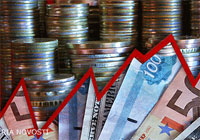Russian economy could grow 6% annually in 2014-2016 with structural modernization – minister

(Interfax – MOSCOW, April 29, 2013) The Russian economy could be in a position to achieve 6% annual growth in 2014-2016 with structural modernization, Economic Development Minister Andrei Belousov said.
“The use of these reserves (structural modernization mechanisms) will enable us to enter a trajectory of 6% growth in 2014-2016 and almost 7% a year in 2017-2020. This level is definitely the limit from the point of view of the Russian economy’s technological and production capability, but one that is theoretically achievable,” Belousov said at a meeting of Economic Development Ministry officials.
The difference in a rate of growth of 3% per year, as is predicted in the basic scenario forecast, and 5% – “is not quantitative, but qualitative and key. These are two different development regimes, two different growth modules and the watershed between them is to carry out a structural modernization mechanism, which will include four key components,” he said.
First, there are institutional changes “ensuring a radical improvement in the business climate, development of competition, support of exports and development of small business.”
Second, the minister added, there are resource maneuvering in favor of healthcare and education at the same time as reforms in these areas.
Third are large-scale infrastructure projects.
Fourth is the need to ensure fast technology development, including in the defense industry.
Belousov once more raised the issue of financing investment in infrastructure projects. “Let us ask the question – why are we accumulating oil and gas revenues?”
When the Stabilization Fund was created there was a fixed ruble exchange rate, the influx of oil money generated the issue of money and triggered inflation. “That is why getting oil revenue out of the economy and into a Stabilization Fund supported macroeconomic balance and contained inflation,” the minister said.
“Now we have an almost floating rate. So the question now is – why are we accumulating oil and gas revenue? They say it is insurance against a new crisis. But that works if oil prices go down and then return to their former level in two to three years. But what if they just move to a new lower level – $70-$80 per barrel, then we will simply eat up the reserves in 2-3 years and be left without any money and without roads. So it makes more sense, we think, to use part of these reserves to sort out bottlenecks in infrastructure, in this way saving a key resource – time,” the minister said, adding that this can be done without violating the budget regulation.
“Calculations show that with structural modernization we can ensure around four percentage point growth in GDP through consumption, which will increase following an increase in labor productivity and salaries. Another three percentage points or so can be achieved through increased investment and from 0.5 to 1 percentage point from growth in non-energy exports. Taking into account increased imports these factors will together provide 6%-7% GDP growth, Belousov said.
“Perhaps this bar (for growth) is too high. But these are real objective challenges that we face, that Russian society faces, and there is not much time to resolve them,” he said.
